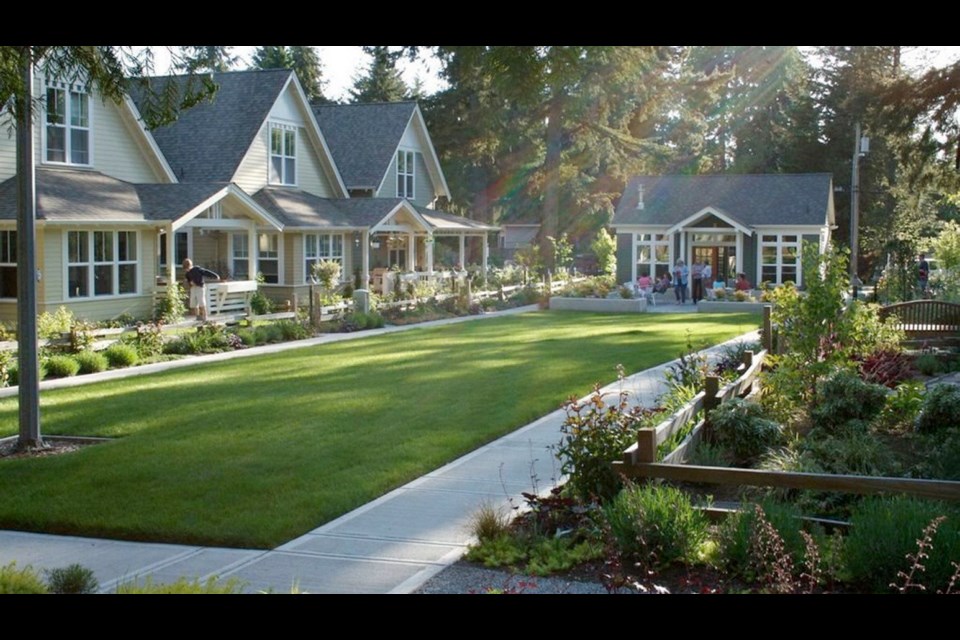Ross Chapin is re-envisioning the neighbourhood.
Chapin, an architect from Whidbey Island, Wash., wants to bring back a stronger sense of community to the places where we live. He’s doing that by promoting what he calls pocket neighbourhoods, small clusters of homes that share a common green space and are designed to promote interaction.
Chapin believes people are longing for simpler lives with more interpersonal connection. It’s the kind of existence he knew growing up in a cottage on a Minnesota lakeshore, in a neighbourhood steeped in what he called “porch culture” — where people had reason to venture outside their homes, where kids could roam and where neighbours interacted on a regular basis.
Yet since the middle of the 20th century, homes and neighbourhoods have gotten bigger, communities have been designed to accommodate cars instead of pedestrians, and living spaces have become oriented toward the rear of the house and the backyard.
Americans have been sold on the need for privacy, Chapin said, and community has suffered as a result.
Chapin thinks a hunger exists for a better balance, a living situation that promotes interaction but still respects privacy. “How do we live smaller, live smarter and live together?” he asked.
He’s sought to achieve that by designing or developing pocket neighbourhoods around the country. Over about 10 years, he worked with Seattle developers Jim Soules and Linda Pruitt to build six pocket neighbourhoods in and around that city, and he’s designed dozens more for areas around the country.
Chapin has written a book on the subject, Pocket Neighborhoods: Creating Small Scale Community in a Large Scale World. He also has a website, pocket-neighborhoods.net.
The purpose of a pocket neighbourhood is to put a dozen or so households in close proximity and give the residents an incentive to interact daily. It’s not a commune — more like a cosy block.
The size of the pocket neighbourhood is important, Chapin said. He recommends eight to 12 households — enough to create a lively, diverse cluster, but not so many that neighbourliness is lost.
Shared space is another key element, such as joined yards, a garden courtyard or a pedestrian street. It’s a place where kids can play, where neighbours might share a community garden or picnic, and where residents spend time or pass through regularly, Chapin said.
Chapin’s pocket neighbourhoods have some other distinctive features. For one, he turns the houses around, so their fronts face the shared space. For another, he incorporates front porches that are big enough to be usable. He builds smaller homes that encourage people to do more living outside, and he advocates common gardens and buildings, such as a shed to house shared lawn and garden tools or a multipurpose room for community potlucks and gatherings.
He prefers to create a parking area away from the houses, requiring the neighbours to walk through the common area on their way to and from their homes and increasing the chance of encounters.
But he recognizes that’s a drawback in colder climates, so he’s willing to compromise. One option, he said, might be a lane leading to attached garages that are shielded from both the street and the common area.
Even though pocket neighbourhoods promote interaction, Chapin still emphasizes the importance of privacy. He creates intentional transitions between public and private spaces, and he designs and orients houses so the residents can’t look out their windows into their neighbours’.
It’s “community on your terms,” he said.
The benefits to pocket neighbourhoods are many, Chapin said. As neighbours become closer, they help and watch out for one another. Security is enhanced, because unfamiliar people in the common space are more likely to be noticed. And children in the neighbourhood have lots of adults involved in their lives, as well as a safe area to play and explore the outdoors.
While Chapin’s neighbourhoods are built from the ground up, the pocket neighbourhood concept can translate to existing neighbourhoods, he said. Neighbours might remove fences to create a shared yard where children can play, for example, or they might reclaim an alley as a gathering space. “The first part is, shift your attitude,” he said.
Chapin thinks pocket neighbourhoods are a better fit for today than sprawling suburbs. More than 60 per cent of U.S. households comprise only one or two people, he noted — singles, empty nesters, young children and single parents with one child. They don’t need oversized homes, and many don’t want solitary lives, he said.
He said baby boomers, in particular, respond positively to the concept. As they’re aging, they’re showing a preference for more interpersonal connection, as well as reasonably sized homes that minimize impact on the environment, he said.
Yet zoning codes often prohibit the kind of living arrangement Chapin promotes.
“People are resistant to change,” he said. Builders and planners are used to building homes and neighbourhoods a certain way, he said, and home buyers often aren’t aware of other options.
He believes changing that situation will require motivated people talking to their local planners and council representatives and approaching builders or developers who might be open to the idea of creating pocket neighbourhoods. He said those builders and developers will do the “muscle work” required to break down the institutional barriers to pocket-neighbourhood development, but only if there’s demand from buyers.
Chapin hopes more people will want to move away from the isolated housing arrangements that have become increasingly common. People are social creatures. If they’re kept in isolation long enough, they go mad, he said.
Instead, he wants to feed our social instincts.
“I’m trying to get back to our human nature,” he said.
